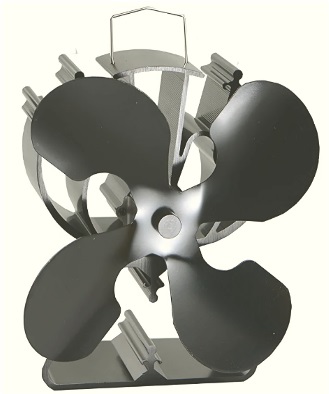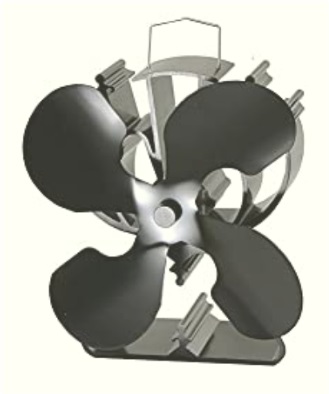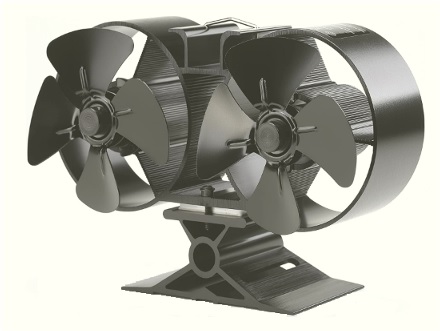A cheap accessory that compliments any wood stove is a fan that can gently push hot air around to warm every corner of the home.
This article will detail what a heat powered fan is, why you should use one, the advantages over other types of fan’s, some heat powered wood stove fan recommendations, and what to look for when buying a heat powered wood stove fan.
- What is a heat powered fan?
- Why use a fan with a wood stove?
- Reasons to use a wood stove fan
- What are the advantages of a heat powered wood stove fan?
- How does a heat powered wood stove fan work?
- What to look for when buying a heat powered fan
- Best selling heat powered wood stove fan
- Highest airflow heat powered wood stove fan
- Best value for money heat powered wood stove fan
- FAQ
What is a heat powered fan?
A heat powered wood stove fan, often called a Thermoelectric fan or Eco fan, uses no electrical power source to create air flow. Instead, the hot surface temperature the stove powers an integral thermoelectric generator built into the heat powered fan.
A heat powered wood stove fan will sit on top of the stove, heating the thermoelectric module, which causes the fan blades to turn, resulting in the warm air blowing from the wood stove out and into the room.
Why use a fan with a wood stove?
A deficiency of wood stoves that they warm a room by radiating heat. This means they get hot, very hot, and then the air near them is also hot. The problem is that the further away from a wood stove you get, the less warmth is radiated. This leaves a high temperature range difference between close to the wood stove, and further away.
An easy and cheap solution is to use a fan to push the warm air away from the stove. Pushing some warm air away from the hot zone will help to warm a larger area more quickly, making for a more comfortable environment. A fan used in conjunction with a wood stove will heat more air volume than a wood stove without a fan.
A fan typically costs less than 5% of the cost of a wood stove, making the small investment of a stove fan a very sensible value add. If you consider the investment of a wood stove, adding an inexpensive appliance like a fan will provide an outside return on investment.
Reasons to use a wood stove fan
Not everyone needs to use a fan with their wood stove, but most people would likely agree that using a fan in conjunction with a wood stove would improve the heating performance of their wood stove.
Consider the below situations where a wood stove fan would be a good idea;
- You want to heat a larger area.
- You want to spread warmth to a larger area more quickly.
- You want to minimize the use of firewood to heat an area, maximize wood stove efficiency.
- You want an even distribution of heat throughout a room.
- A wood stove is undersized for the area it is trying to heat.
- The wood stove has been placed in a location that is not ideal to radiate heat to the desired area.
What are the advantages of a heat powered wood stove fan?
There are a few benefits of a heat powered fan over an electrically powered fan.
- Inexpensive, heat powered wood stove fans are cheap, very few moving parts.
- Operational costs, heat powered fan do not use electricity to operate.
- Safety, heat powered fans do not require electricity, no messy power cords that can get melted.
- Convenience, power outlets are not always readily available near a wood stove.
- Silent operation, heat powered fan are very quiet.
- Floor space, heat powered fans are placed right on top of the heat source, no floor space is required.
- Heat resistance, heat powered fan are made to get hot, standard fans can melt if subjected to too much heat.
How does a heat powered wood stove fan work?
The secret to a heat powered fan is that electrical energy is created by an inbuilt thermoelectric generator. The thermoelectric generator, also call a peltier device (or peltier module), creates a small amount of electrical power, just large enough to turn the blades of a small fan.
The peltier device creates electrical power when there is a heat differential on its surface from one side to the other. The greater the heat difference, the more electrical power is created.
A heat powered fan will usually have a smooth solid base that sits on top of the wood stove. The peltier device is placed on top of the base. On top of the peltier device is a heat sink.
The smooth base radiates as much heat as possible into the underside of the peltier device. The upper side of the peltier device is attached to the heat sink, which aims to radiate as much heat as possible, thereby reducing the heat on the top of the peltier device.
The heatsink is the secret here.
The more heat that the heat sink can dissipate, the higher the heat differential across the peltier device, the more electrical energy can be created. The peltier device is connected to the base and heatsink with a heat transferring paste for maximum efficiency.
The peltier device is connected to a small electrical motor which drives the fan blades, which push the warm stove air away from the wood stove.
We have covered more detail on how heat powered fans work here.
What to look for when buying a heat powered fan
How to choose a heat powered wood stove stove fan? In order of importance, the key specifications to look for when buying a heat powered fan are;
- Air flow rate, the higher the air flow rate, the more air can be pushed.
- Maximum temperature, a high maximum temperature is a sign that the heat powered fan is robust and will last a long time.
- Size, the bigger a heat powered fan the more likely it will push more air, and handle higher temperatures better. Conversely a larger heat powered fan with lots of heavy blades will usually require more temperature to start moving the blades.
- Noise level, heat powered fans are usually very gentle in the operation, and therefore not very loud, but this specification is usually quoted and should be checked.
- Start temperature, there will be a minimum temperature the wood stove must heat up to before the fan blades will start moving. The lower the temperature the quicker a room will heat up. Unfortunately a lower start temperature, (usually but not always), means a smaller fan (see point on size above).
Best selling heat powered wood stove fan
VODA 4-Blade Heat Powered Stove Fan
 |
Model number |
VDSF624B |
|
|
||
Highest airflow heat powered wood stove fan
OCROUKI Wood Stove Fan
 |
Model number |
HL-500P |
|
|
||
Best value for money heat powered wood stove fan
JOSSACOLAR Dual Motor Heat Powered Wood Stove Fan
 |
Blades |
4 |
|
|
||

